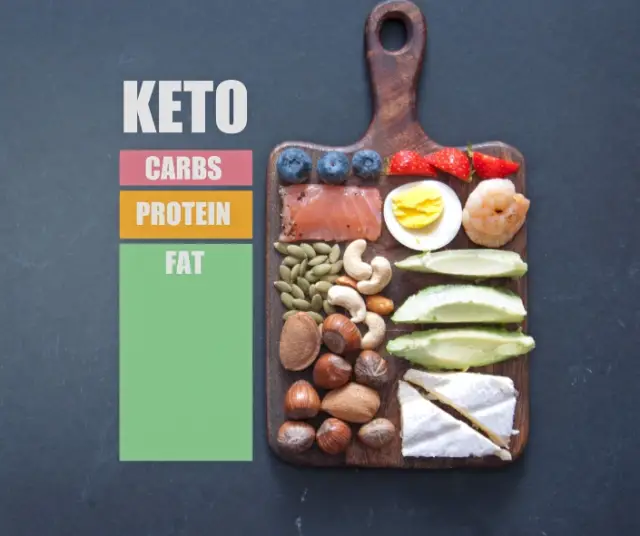The ketogenic diet, commonly known as the keto diet, has gained popularity in recent years as an effective approach to weight loss and improving metabolic health. This diet is characterized by being low in carbohydrates and high in fat, which induces the body to enter a metabolic state called ketosis.
What is the Keto Diet?
The keto diet is an eating plan that focuses on drastically reducing carbohydrate intake and increasing healthy fat intake. By limiting carbohydrates, the body enters a state of ketosis, in which it uses stored fat as an energy source instead of carbohydrates. This metabolic change has significant effects on weight loss and overall health.
Fundamental Principles
The basic principles of the keto diet are:
- Drastically reducing carbohydrates: Limit carbohydrate intake to around 5-10% of total daily calories, which is equivalent to approximately 20-50 grams of carbohydrates per day.
- Moderate protein intake: Protein intake is kept at a moderate level, around 15-25% of daily calories.
- High fat intake: Most calories come from fat, approximately 70-80% of daily calories.
Benefits of the Keto Diet
One of the most notable benefits of the keto diet is its effectiveness in weight loss. Ketosis allows the body to burn fat more efficiently, which leads to weight loss, especially in the first few weeks of the diet.
Blood Sugar Control
The keto diet can help control blood sugar levels, which is beneficial for people with type 2 diabetes or prediabetes. By reducing carbohydrate intake, the need for insulin is decreased.
Greater Energy and Mental Clarity
Many people who follow the keto diet report more stable energy levels throughout the day and greater mental clarity. This is due to the stabilization of blood sugar levels and the efficient use of fat as an energy source.
Reduction of Appetite
The keto diet tends to reduce appetite, which can help with portion control and adherence to the diet. Fats and proteins tend to be more satiating than carbohydrates.
Important considerations
Possible Side Effects
Some people experience side effects when starting the keto diet, such as the "keto flu," which includes symptoms such as fatigue, nausea, and difficulty concentrating. These symptoms are usually temporary and can be relieved with proper hydration and electrolyte supplements.
Micronutrient Requirements
Reducing your carbohydrate intake can result in a lower intake of certain nutrients, such as fiber, potassium, and magnesium. It is important to make sure you include foods rich in these nutrients or consider supplements.
Medical consultation
Before starting the keto diet, it is important to speak with a health professional, especially if you have pre-existing medical conditions. The keto diet is not right for everyone, and a doctor can provide personalized guidance.
Allowed and Prohibited Foods on the Keto Diet
Allowed Foods
- Healthy fats: olive oil, avocados, coconut oil, nuts and seeds.
- Lean proteins: lean beef, chicken, turkey, fish and eggs.
- Low carb vegetables: spinach, broccoli, kale, cauliflower, etc.
- High-fat dairy: cheese, Greek yogurt, butter.
- Sugar-free drinks: water, coffee, tea and some carbohydrate-free soft drinks.
- Low carbohydrate sweeteners: erythritol, stevia and sucralose.
Forbidden food
- Sugars and sugary foods: soft drinks, cakes, cookies, candies, etc.
- Trans fats: processed and fried foods.
- Grains and cereals: bread, pasta, rice, oats, etc.
- Legumes: beans, chickpeas, lentils, etc.
- Fruits rich in carbohydrates: bananas, grapes, mangoes, etc.
- Processed foods: fast foods and high carbohydrate products.
Tips for a Successful Keto Diet
Following a keto diet can be challenging, but with proper planning and the right information, you can achieve your goals in a healthy way. Here are some tips for a successful keto diet:
1. Detailed Meal Planning
Meal planning is a cornerstone of the keto diet. Create a weekly plan that includes breakfasts, lunches, dinners and snacks. Make sure you balance fats, proteins and carbohydrates to meet your daily goals. This will help you avoid falling into unwanted food temptations.
2. Food Preparation
Take time to prepare your food in advance. Cook large batches of proteins and vegetables, and store them in individual servings. This makes it easier to track your macronutrient intake and prevents you from turning to unhealthy options when you're hungry.
3. Read Labels Carefully
Processed foods can contain hidden carbohydrates and unwanted sugars. Learn to read product labels to identify these ingredients and avoid unpleasant surprises. Pay special attention to terms like maltitol and other sugar alcohols that can have an impact on blood sugar levels.
4. Maintain Hydration
The keto diet can have a diuretic effect, meaning you may lose more fluids and electrolytes than usual. Be sure to maintain adequate water intake and consider supplementing with electrolytes, such as sodium, potassium, and magnesium, to prevent dehydration and side effects such as fatigue and cramps.
5. Portion Control
Even on a keto diet, portion control is key. Calories still matter, and consuming more calories than you burn can lead to weight gain. Use tools like kitchen scales and mobile food tracking apps to control your portions and maintain proper macronutrient balance.
6. Ketosis Monitoring
If you're following the keto diet to achieve ketosis (a state in which your body burns fat as its primary source of energy), consider using ketosis test strips. These strips will help you monitor your ketosis levels and make sure you are in the right range to achieve your goals.
7. Seek Support
Changing your eating habits can be emotionally challenging. Seek support from friends, family, or online groups following a keto diet. Sharing your experiences and receiving advice from people in similar situations can be motivating and comforting.
If you decide to follow the keto diet, remember that the key to success is planning, patience and consistency. By choosing foods rich in healthy fats and lean proteins, and maintaining a proper balance of nutrients, you can experience the benefits of the keto diet and live a healthier, lower-carb lifestyle.
